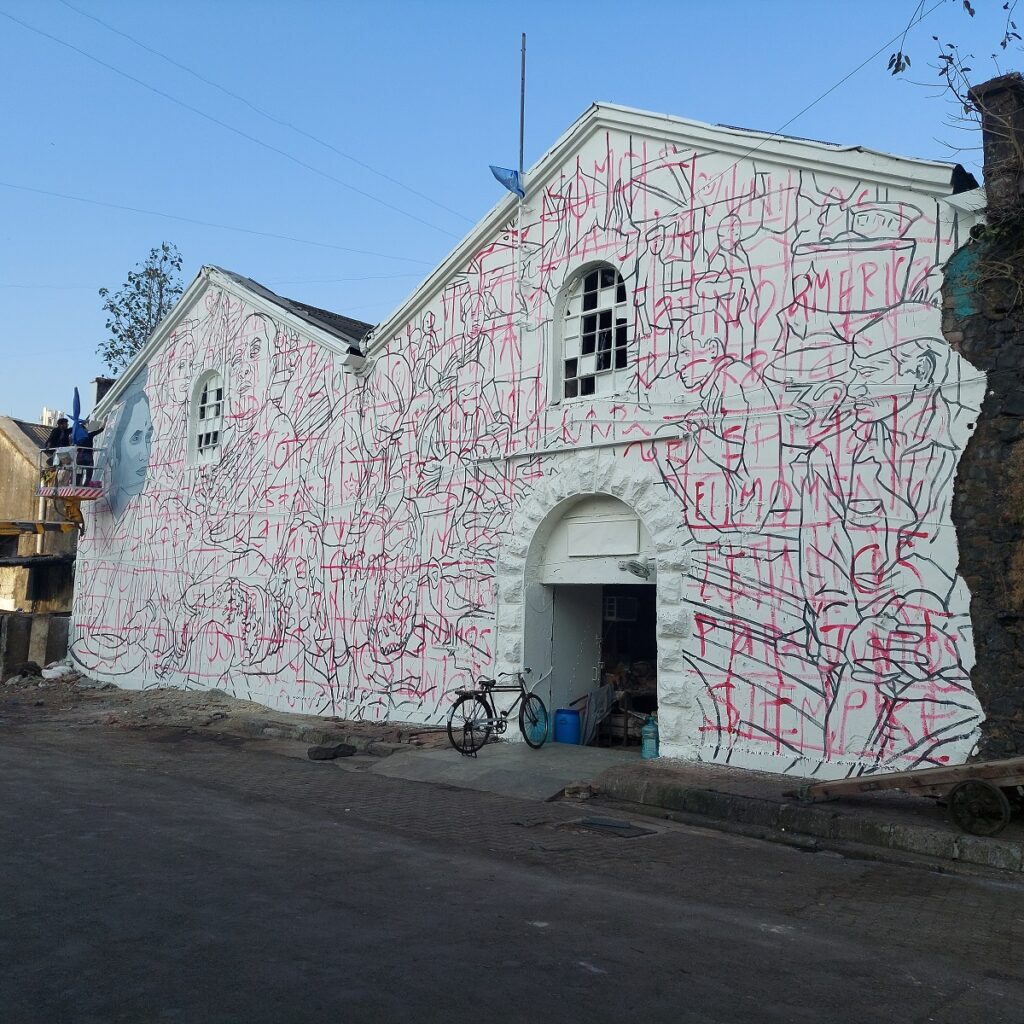At the three-month long Mumbai Urban Art Festival (MUAF) viewers are forced to consume art in the full energy of the city and the sea.
At the three-month long Mumbai Urban Art Festival (MUAF), viewers are forced to consume art in the full energy of the city and its sea, which makes it fully urban. MUAF has turned art engagement upside down as viewers are forced to consume art in the full energy of the city and the sea.
The festival, organized by St+art India and corporate firm Asian Paints, is themed — Between the Sea and the City — and is inspired by Mumbai’s sea-related history. The exhibition is currently on at the Sassoon Dock, one of the oldest docks in the country.
The viewer is kept unsettled by the immediate environment as they encounter art displayed within the raw warehouses of the Sassoon Dock.
Mumbai Urban Art Festival takes the idea of street art to the next level as it includes the roughness of the street which is productively intersected with the notion of the white-cube gallery.
Infamous smell and action-filled streets
As public places in the country are shrinking and are taken over by land sharks, MUAF helps keep the publicness of the Sassoon Docks, at least provisionally, intact.
The festival throws light on the urban character of Mumbai. Though it is not sanitizing the environment of the mega city, in its curation, MUAF is rich in depicting its infamous smell, orderless sights, ear-piercing sounds, and action-filled streets.
The grittiness of this exhibition is in its bold embracing of the stinking smell of fish, the heavy air gleefully nauseating the warehouse, and the activated life of peripheral spaces, which are conspicuous by their absence in the air-conditioned, white-boxed, and doored popular art galleries which are often domesticated and fairly sanitized.
Much like a large vessel, the lowest floor, which drones, gurgles, bubbles and dabbles, takes the viewer into a deep water experience. Here, artworks that expose the geography of the deep sea are showcased.
An astronomical handwoven net made out of discarded plastic engulfs the viewer at the exhibition. In this work — Sea never dries — the Ghana-based artist, Serge Attukwei Clottey, interweaves memories of the yellow plastic containers used for the import of cooking oil from the West.
Abuses and commodification of the sea
Further in the space of the typographic hall, walls impart a phenomenal experience with the texts and languages by French artist Rero.
Executed by Arif Alam Khan, the black and white letters come to life in the day-lit warehouse. The flipped letters begin to appear straight in their reflections within the mirror fragments on the floor.
The space also houses videos that speak of the abuses and commodification of the sea. Meera Devidayal’s three-channel video work — Water has memory — forces viewers to take some time to reflect on the current state of the sea and its blue water.
Khyati Trehan’s digital screens speak of migration, movement and materials on the sea. Parag Tandel’s sculptures illuminate the translucent bodies of deep sea creatures. Sajid Wajid Shaikh and Ronak Soni shed light on leakages from PVC pipes, and Sohrab Hura’s immersive video work of coast/shore is cleverly placed between leakages and the sea or the dry and the wet.
Naman Saraiya and Nikita Rana with their photo dumps within toilet spaces remind us of the palimpsest of messages left on the walls of public toilets that drain bodily wastes into the sea.
As the viewer moves on, he/she is met with an airy volume of textual work, sandwiched generously between a large scale wall mural and Sameer Kulavoor and Sandeep Meher’s scaled models of the metamorphosing city.
A close look at the models reveals the intricate materials and political intertwinements within the built environment of Mumbai. Mounted and morphed within the plastic containers used to carry fish, the installation indexes social, economic and political histories that account for the city’s sprawling development.
Stories of fisherfolk, rituals and myths
The enterprise and grimness of the city are captured in the coloured trays and concrete greys clinging onto each other like the solidified debris within the sea.
Next, the large mural by Australian artist Guido Van Helten, preserved from the last season of MUAF, on the opposite wall begins to gaze at the viewer standing in the metamorphosing city blocks through the larger-than- life text on the adjacent wall, reading, “How many generations does it take for a dream to come true?”
By looking at these three artworks together, memories of the city, stories of rehabilitation, its redevelopment, horizons of hopes and aspirations with which people migrate to the city coalesce together.
The remaining halls tell the fantastic stories of fisherfolk, their works, rituals, myths, colour and celebration, by the Kerala-based artist collective Trespassers. The women’s toilet is intervened by another typographic work by Koshy Brahmatmaj, followed by a gender neutral toilet right above set up by the Gaysi family, which is as embracing as the art within it.
Along the staircase is another interactive, gentle yet provocative typographic installation by Mumbai-based Aqui Thami in the form of bills, asking viewers to fill up their names and how they are making the city.

